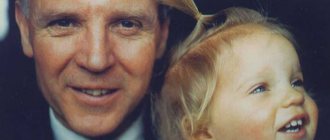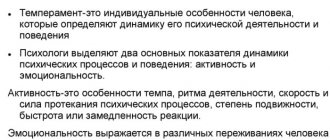Eight stages of personality development according to Erik Erikson. Theory of psychosocial development.
According to psychologist Erik Erikson, all people in their development go through eight crises , or conflicts.
Model of personality development.
Erikson developed a model of personality development that covers the entire period of human life. The main concept of his theory is “ego identity” or, in other words, the integrity of the individual. The formation of ego identity continues throughout a person’s life and goes through a number of stages.
Erikson identified 8 stages of personality development from birth to death.
| Age | Stage name |
| 0-1 | Trust or mistrust. |
| 2 — 3 | Independence or indecisiveness |
| 4 — 5 | Entrepreneurship or guilt |
| 6 — 11 | Skill or inferiority |
| 12 — 19 | Identity or role confusion |
| 20 — 25 | Early maturity. Intimacy or isolation |
| 26 — 64 | Average maturity. Productivity or inertia |
| From 65 years old | Late maturity. Integration or despair |
Stage 1.
Trust or distrust (0-1 year).
trust vs. mistrust
This stage covers the first year of life. At this stage, the sensory systems mature. That is, vision, hearing, smell, taste, and tactile sensitivity develop. A person is thirsty for new experiences, he masters the world .
At this stage, as at all subsequent ones, there are two paths of development: positive and negative.
| Positive way | Negative way |
| The child gets everything he wants. All the child’s needs are quickly met. As a result, the world is a cozy place where people can be trusted. The result of a positive path: The child develops the ability to form warm, deep, emotional relationships with other people, and optimism. If a small child could speak, he would say: “I am loved,” “I feel cared for, reliable.” | The mother’s focus is not on the child, but on caring for him or educational measures, or her own career, disagreements with relatives, anxieties of various kinds, etc. The result of the negative path: Distrust, suspicion, fear of the world and people, and pessimism are formed. |
Stage 1 Summary: oral-sensory. Psychosocial crisis: Basic trust – basic mistrust. Originally Answered: Can I trust the world? The strength is hope.
Up
Stage 2.
Independence or shame and indecisiveness (2-3 years)
autonomy vs. shame and doubt
This stage covers the second and third years of life. The second stage of personality development, according to E. Erikson, consists of the child forming and defending his autonomy and independence . It begins from the moment the child begins to walk . At this stage, the child masters various movements, learns not only to walk, but also to climb, open and close, hold on, throw, push, etc. Children enjoy and are proud of their new abilities and strive to do everything themselves .
| Positive way | Negative way |
| Parents give the child the opportunity to do what he is able to do, do not limit his activity, and encourage the child. At the same time, parents should unobtrusively but clearly limit the child in those areas of life that are dangerous for the children themselves and others. The child does not receive freedom, his freedom is limited. The result of a positive path: the child gains independence; autonomy; a feeling is developed that he controls his body, his aspirations, and to a large extent controls his environment; the foundations of free self-expression and cooperation are laid; self-control skills are developed without compromising one’s self-esteem; will. “Mom, look how great it is. I own my body. I can control myself." | Parents limit the child’s actions, parents are impatient, they rush to do for the child what he himself is capable of, parents shame the child for accidental offenses (broken cups); or vice versa, when parents expect their children to do something that they themselves are not yet able to do. The result of the negative path: the child develops indecision and lack of confidence in his abilities; doubt; dependence on others; a feeling of shame in front of others is consolidated; the foundations are laid for constrained behavior, low sociability, and constant vigilance. “My body is bad and I myself am bad”, “I have to control everything I do very carefully.” “I want to be independent, but I’m afraid that I won’t succeed.” |
Stage 2 Summary: Muscular-anal. Psychosocial crisis: Independence – shame and doubt. Originally Answered: Can I control my body? Strength is willpower.
Up
Stage 3.
3. Initiative or guilt (4-5 years).
initiative vs. guilt
Other translation options: enterprise and inadequacy.
Children aged 4-5 years transfer their research activity beyond their own bodies. They try to become independent and explore their limits. They learn how the world works and how they can influence it. The world for them consists of both real and imaginary people and things.
Positive path of development:
If children's exploration activities are generally effective, they learn to deal with people and things in a constructive way and gain a strong sense of initiative .
Parents, encouraging the child’s energetic and independent endeavors, recognizing his rights to curiosity and imagination, contribute to the development of initiative , expanding the boundaries of independence , and the development of creative abilities .
Negative path of development.
Close adults who severely limit freedom of choice, overly control and punish children, cause them to feel too much guilt . Children overwhelmed by guilt are passive , constrained and have little ability for productive work in the future.
Phrases from parents: “You can’t, you’re still small,” “Don’t touch!”, “Don’t you dare!”, “Don’t meddle where you shouldn’t!”, “You won’t succeed anyway, let me do it myself,” “Look, how upset your mother was with you"
Stage 3 Summary: Locomotor-genital, age 3-6 years. Psychosocial crisis: Initiative - guilt. Originally Answered: Can I become independent from my parents?
?
Strength is purpose.
Up
Stage 4.
Hard work or feelings of inferiority (6-11 years).
industry vs. inferiority
Between the ages of 6 and 11, children develop numerous skills and abilities at school, at home and among their peers.
According to Erikson's theory, the sense of self is greatly enriched as the child's competence in various areas increases
The child asks himself the question: Am I capable?
Positive way:
When children are encouraged to do what they love, learn new skills (tinkering, cooking, doing handicrafts, even if they are not so good and neat), when they are allowed to finish what they started, praised and rewarded for their results, then the child develops skill and ability for technical creativity.
Negative way:
Parents who see their children’s work as mere “pampering” and “messing up” contribute to the development of their feelings of inferiority.
A child's sense of competence and work ethic are also highly dependent on school performance. If a student learns educational material more slowly than his peers and cannot compete with them, then continuously falling behind in class develops a sense of inferiority in him.
Comparing oneself with one's peers is becoming increasingly important . During this period, negative assessment of oneself in comparison with others causes especially great harm.
Stage 4 Summary: Latent, age 6-11 years. Psychosocial crisis: hard work-inferiority. Answer to the question: Am I capable? Strengths: competence, confidence.
Up
Stage 5.
5.Identity or role confusion (12-19 years old).
identity vs. role confusion
Before adolescence, children learn a number of different roles - student or friend, older sibling, sports or music student, etc. During adolescence and adolescence, it is important to understand these different roles and integrate them into one coherent identity.
A teenager is looking for confidence, security, trying to be like other teenagers in his age group. He develops stereotypical behavior and ideals and often joins various groups or clans . Peer groups are very important for rebuilding self-identity. This is the second major attempt at developing autonomy (after stage 2), and it requires challenging parental and social norms .
Negative path of development: Boys and girls seek basic values and attitudes that cover all these roles. If they fail to integrate a core identity or resolve a major conflict between two important roles with opposing value systems, the result is what Erikson calls identity diffusion .
The teenager becomes distrustful, shy, insecure, filled with guilt and consciousness of his inferiority.
Stage 5 Summary: Adolescence, age 12-19 years. Psychosocial crisis: Self-identity - role confusion. Answer to the question: Who am I? Strength is loyalty.
Up
Stage 6.
6. Intimacy or isolation (20-25 years).
intimacy vs. isolation
In late adolescence and early adulthood, a central developmental tension is the conflict between intimacy and isolation. In Erickson's description, intimacy includes more than sexual intimacy. It is the same as the intimate feeling we have for spouses, friends, siblings, parents or other relatives.
This is the ability to give a part of yourself to another person of any gender, without fear of losing your own identity . Success in establishing this type of close relationship depends on how the five previous conflicts were resolved.
- For example, a person who has difficulty trusting others (stage 1) will have difficulty loving ;
- A person who needs to control himself (stage 3) will find it difficult to allow others to cross his boundary .
- Someone who feels inadequate will find it difficult to be intimate with others.
- And if a person is not sure of his identity (stage 5), then it will be difficult for him to share with others who he is .
Negative path of development.
The inability to establish calm, trusting personal relationships and/or excessive self-absorption leads to feelings of loneliness, social vacuum and isolation.
Read the articles: What is the reason for your loneliness. and 8 types of single (free) women.
Self-absorbed people may engage in very formal personal interactions and make superficial contacts, without showing real involvement in the relationship, because the increased demands and risks associated with intimacy pose a threat to them.
Stage 6 Summary: Early maturity, age 20-25 years. Psychosocial crisis: Intimacy-isolation. Originally Answered: Can I have an intimate relationship? The strong point is love.
Up
Stage 7.
Generativeness or stagnation (26-64 years).
generativity vs. stagnation
In adulthood, after previous conflicts have been partially resolved, men and women can pay more attention to and help other people. Parents sometimes find themselves helping their children. But not only. Productivity appears as the concern of the older generation about those who will replace them - about how to help them gain a foothold in life and choose the right direction.
Some people can direct their energy to solving social problems without conflict. But failure to resolve previous conflicts often leads to excessive self-absorption : one’s health, the desire to satisfy one’s psychological needs, to preserve one’s peace, etc.
Stage 7 Summary: Middle maturity, age 26-64 years. Psychosocial crisis: productivity-stagnation. Originally Answered: What am I going to do with the rest of my life? The strength is caring.
Up
Stage 8.
Ego integrity or despair (over 65 years old).
ego integrity vs. despair
In the last stages of life, people usually reconsider the life they have lived and evaluate it in a new way.
If a person’s life was filled with meaning and active participation in events, then he comes to the conclusion that he did not live in vain and fully realized what fate had given him.
Then he accepts his life entirely , as it is. But if life seems to him a waste of energy and a series of missed opportunities, he begins to feel despair.
It is obvious that one or another resolution of this last conflict in a person’s life depends on the cumulative experience accumulated in the course of resolving all previous conflicts.
8Summary: Stage 8. Late maturity, age from 65 years. Psychosocial crisis: Integrity I am despair. Originally Answered: Did my life have meaning? Strength: Wisdom.
Up
Erik Erikson - (eng. Erik Homburger Erikson; 1902, Frankfurt am Main - 1994, Massachusetts) - developmental psychologist and psychoanalyst.
Erikson contrasted Freud's theory, which divided psychological development into five stages, with his own scheme, in which there were eight such stages.
Erickson renamed the so-called “genital stage” “adolescence” and also added three more adult stages (6,7,8).
Erikson also owns the concept of “ego psychology,” emphasizing the role of the Ego as something more than the “handmaiden of the Id” (in Freudian ideas). It is the Ego that is responsible for organizing life, for ensuring harmony with the physical and social environment, for healthy personal growth; it is a source of self-confidence and personal identity.
Winner of the Pulitzer Prize for Nonfiction for his book Gandhi's Truth.
Share link:
- Click here to share content on Facebook. (Opens in a new window)
- Click to share on WhatsApp (Opens in new window)
Similar
What is ego integration?
The feeling of ego integration represents a sense of the integrity of one's self. Children under 3 years of age do not have their own “I”; they identify themselves with the world around them.
When a person feels comfortable in the world, when the world becomes a place to satisfy all human needs, this is integration. That is, integration is the highest degree of fitness.
According to E. Erikson’s epigenetic theory of personality development, ego integration manifests itself in old age, provided that a person has learned from his own experience moments of joy and the bitterness of defeat, and has inspired others. Such a person is not afraid of death, because she managed to leave a mark behind herself (in creative achievements or her descendants), thereby gaining immortality.
Ego identity
Ego Identity
Erikson emphasized the development of ego identity. Ego identity is the conscious sense of self that a person develops through social interaction, and it becomes the “center” of the psychosocial developmental stage of personality identification and role confusion
According to Erikson, a person's ego identity is constantly changing due to new experiences and information that people gain through daily interactions with others. Personal identity provides an integrated and coherent sense of self that persists throughout a person's life. A sense of personal identity is formed through life experiences and interactions with others, and this identity helps a person guide actions, beliefs, and behavior as they age.
Epigenesis
Epigenesis is the theory that each person develops through a sequence of stages that occur in a natural, predetermined order. The stages are sequential, but they are not hierarchical. At each stage, a person is faced with a crisis or problem that is especially important at that time in life and must be resolved
A person's social environment has an extremely important influence on how each crisis is resolved, but it also does not determine the order in which the stages appear.
Erikson's stages, postulated in the epigenetic theory of social development, are associated with a crisis that must be satisfactorily resolved in order for an individual to develop qualities such as trust, autonomy and initiative, etc. While unhealthy or unsatisfactory resolutions lead to mistrust , shame and doubt, guilt, etc., which can make a person psychologically troubled.
Erik Erikson's theory of personality development among other approaches
Erik Erikson
Erikson's theory does not directly seek to achieve learning, developmental, and pedagogical goals; the concept describes the current situation as the norm and highlights undesirable paths of development. This theory can be considered as a guide for psychotherapeutic activities, and not at all for professionals in personality formation.
Old age (65 years and older)
The conflict of this stage is integrity and hopelessness. In old age, people evaluate their lives - what have I achieved? Did my life have any value?
At the last stage of psychosocial development, self-acceptance occurs. You won’t be able to live life a second time - that’s a fact, and you shouldn’t grieve about it. It is necessary to get rid of the depressing thoughts that something did not work out or there was not enough time for something. You can’t correct the past with such thoughts, but you can ruin the future without much difficulty.
“I am who I have become. My life is the way I lived it. Everything is fine,” such thoughts indicate the successful completion of the psychosocial development of the individual.
We hope you found this article helpful. And to get to know yourself even better, we suggest taking our “Self-Knowledge” course. In this online program, in just 4 weeks, with the help of psychological tests and exercises, you will find out what you really want in life and understand your strengths and weaknesses.
We wish you success!
We also recommend reading:
- Storytelling
- How to teach a child to read: rules, tips and tricks
- A selection of courses for children and parents
- Glenn Doman “Harmonious development of the child” - summary
- Formation of self-awareness
- Masaru Ibuka “After three it’s too late” - summary
- How to motivate a child to read?
- Socialization of personality: briefly about the main thing
- Factors in a child’s intellectual development
- Getting ready for the new school year
- Piaget's theory of cognitive development
Key words:1Self-knowledge
Mature (25-65 years old)
An important point of this stage is creative implementation. In adulthood, a person needs to make a choice between generativity and stagnation, between productivity and inertia.
During this stage, a person focuses on career and family. Successful completion of this stage brings the individual the feeling that he is realizing his own potential and making his feasible contribution to the development of the world.
But many people experience a feeling of meaninglessness, hopelessness and disappointment - a midlife crisis.
Important questions at this stage are:
- What is the significance of my life today? What have I achieved? What can I be proud of?
- How should I spend the rest of my life? What should I do and what can I do?
At the stage of maturity, care is formed, not only about the family, but also care towards oneself. There is no need to devalue your achievements and belittle yourself.
Preschool or play age (3-6 years)
Children begin to interact more actively and consciously with peers and become interested in various work activities. The social world requires the child to develop new skills and solve new problems for the child.
At this stage, the child’s initiative is formed. Parents should encourage the child’s independent endeavors and should give him the opportunity to show imagination, curiosity and creativity.
Overprotection and too strict boundaries limit the child’s field of imagination, and also create a feeling of guilt in him. Children in such a situation become passive and constrained.
Erickson biography
The son of a Danish father and a Jewish mother, the future great psychologist and psychoanalyst Erik Erikson was born in 1902 in Germany, near Frankfurt. His parents divorced before he was born, and his mother subsequently married Dr. Theodor Homburger. Little Eric did not know for several years that Dr. Homburger was his stepfather. Later, when he signed his first articles on psychoanalysis and psychotherapy, Erickson used his stepfather's surname, although when he became a naturalized American citizen in 1939, he chose his father's surname.
Unlike other personologists, Erickson did not receive formal college education after graduating. He attended a "humanistic gymnasium" in Germany and, although a mediocre student, excelled in the study of history and art. Shortly after graduating from high school, Erickson traveled to Central Europe, despite his stepfather encouraging him to become a doctor. A year later he entered art school, but soon could no longer sit still and went to Munich to study at the prestigious Academy of Fine Arts. Two years later, Erickson traveled to Italy, visiting Florence, sunbathing and wandering art galleries.
In 1927, the "work freeze" ended and he was hired as a teacher at a small American experimental school in Vienna on the recommendation of a classmate, Peter Blos. The school was founded by Anna Freud for children whose parents were trained in psychoanalysis. Some of Erikson's young students were themselves psychoanalysts, and "Herr Erik," as he was affectionately known, joined them.
Erickson began studying psychoanalysis at a mountain resort near Vienna. There, as a private teacher, he first met the Freud family and was then accepted as a candidate for teaching at the Vienna Psychoanalytic Institute. From 1927 to 1933, Erikson continued his psychoanalytic research with Anna Freud. This was his only formal academic training, other than a certificate issued by the Maria Montessori Teachers' Association in Vienna. Maria Montessori in Vienna. In Vienna, Erikson married Canadian Joan Serson, who also attended Anna Freud's experimental school. In 1933, Erikson's family (including two sons) traveled to Copenhagen, where Erikson attempted to gain citizenship and help establish a center for teaching psychoanalysis in that country. When it became obvious that this idea was not feasible, the family emigrated to the United States and settled in Boston, where a psychoanalytic society had been founded a year earlier. Erickson practices in Boston for the next two years, specializing in the treatment of neuroses, anxiety, sleep disorders and other disorders in children. He also served on the staff of the Henry Murray Clinic at Harvard and served as a fellow in psychology in the Department of Neuropsychiatry at Harvard Medical School. Erikson was even accepted as a candidate for a doctorate in psychology at Harvard, but he dropped out of that research program after failing his first course.
In 1936, Erickson was hired by Yale University School of Medicine as a faculty member. In 1938, he went on an expedition to the Pine Ridge Reserve in South Dakota to observe the raising of children among the Sioux Indians. This study marked the beginning of Erikson's interest in studying the influence of culture on child development, a topic to which he devoted much of his subsequent professional life.











